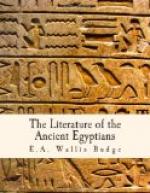“Hail, all ye who arrive in this funeral mountain, present ye unto me offerings, cast incense into the flame and pour out libations at every festival of Amentet.”
The scribe and sculptor, the councillor, the chief of the mysteries of the House of Shent in Tenen, the priest of Horus, Imhetep, the son of the priest Kha-Hap, whose word (or voice) is truth, cut this inscription.
[Footnote 1: These words mean, “The king gives an offering,” and the formula is as old at least as the fourth dynasty. It is obvious that the king could not make a funerary gift to every one who died, but the words are always found in funerary texts down to the latest times.]
[Footnote 2: October-November.]
[Footnote 3: May-June.]
[Footnote 4: The Hall of Offerings in the tomb.]
[Footnote 5: The raising of the Tet pillar was an important ceremony, which was performed at the annual miracle-play of Osiris; it symbolised resurrection.]
[Footnote 6: This was the official title of the high-priest of Memphis.]
[Footnote 7: May-June.]
[Footnote 8: December—January.]
[Footnote 9: The great Death-god.]
CHAPTER X
TALES OF TRAVEL AND ADVENTURE
THE STORY OF SANEHAT
The text of this very interesting story is found written in the hieratic character upon papyri which are preserved in Berlin. The narrative describes events which are said to have taken place under one of the kings of the twelfth dynasty, and it is very possible that the foundation of this story is historical. The hero is himself supposed to relate his own adventures thus:
The Erpa, the Duke, the Chancellor of the King of the North, the smer uati, the judge, the Antchmer of the marches, the King in the lands of the Nubians, the veritable royal kinsman loving him, the member of the royal bodyguard, Sanehat, saith: I am a member of the bodyguard of his lord, the servant of the King, and of the house of Neferit, the feudal chieftainess, the Erpat princess, the highly favoured lady, the royal wife of Usertsen, whose word is truth in Khnemetast, the royal daughter of Amenemhat, whose word is truth in Qanefer. On the seventh day of the third month of the season Akhet, in the thirtieth year [of his reign], the god drew nigh to his horizon, and the King of the South, the King of the North, Sehetepabra,[1] ascended into heaven, and was invited to the Disk, and his divine members mingled with those of him that made him. The King’s House was in silence, hearts were bowed down in sorrow, the two Great Gates were shut fast, the officials sat motionless, and the people mourned.
[Footnote 1: i.e. Amenemhat II.]




